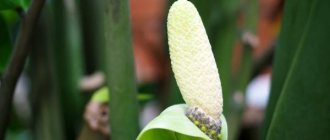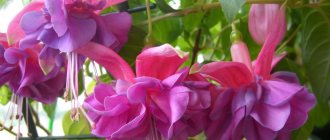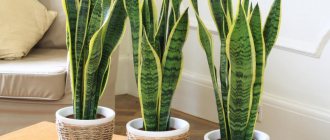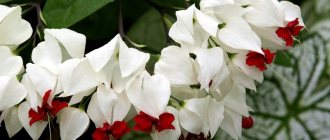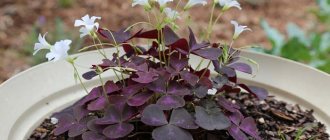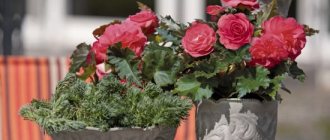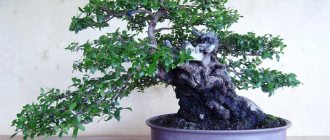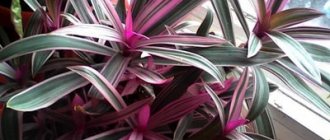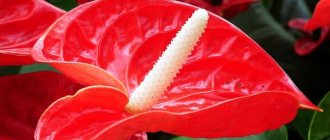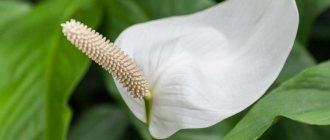In this article we will look at interesting facts about such an aristocratic flower as Clivia. It is worth noting that Clivia has many varieties, but they all have one interesting feature - the absence of a stem, but there are dense leaves collected in a rosette at the base, which change their color depending on the age of the flower.
Based on the mystical side of our existence, we will find out how this perennial plant can be useful in life, how it affects a person’s energy, what upcoming events can characterize the period of its flowering, what it will protect from and for whom it will be a talisman.
Popular beliefs
Clivia fascinates with her beauty. But despite all its external attractiveness, the flower carries a certain degree of danger. Let's figure out which one it is.
Positive
Clivia is most suitable for people born under the sign of Sagittarius. Active and mobile, they will be able to feed on the missing energy from this African giant. Sagittarius can safely grow a plant, being confident that it will bring them good luck in all their endeavors. For those suffering from cardiovascular diseases, clivia will help you feel better.
Negative
Carefully observing a pot of clivia standing on the windowsill, we can safely state: if the flower bloomed at the right time and then abruptly completed this process, then a black streak is expected in the life of the household. The withering of the leaves of a tropical plant in any season also promises trouble.
Remember: the brighter the clivia blooms, the more poisonous it is.
A decorative friend, according to popular rumor, is capable of causing a quarrel between a husband and wife and causing confusion in their relationship.
What is a "stone rose"?
Among the people, the plant has received many names: echeveria (echeveria), stone rose, young, hare cabbage and “tenacious”.
The appearance resembles a blooming rose, hence the name. The stone rose is named after the naturalist artist from Mexico - Echeveria. The plant seems to be carved from stone.
The flower looks very impressive at home, in a greenhouse, and lasts a long time in a bouquet.
Stone roses are often used in landscape design due to their many colors. There are also many varieties of “tenacious”: red, green, yellowish or purple, etc.
Echeveria looks like a rose with a short stem. The leaves are dense, arranged in a circle. It is a perennial plant and is evergreen.
Can I keep it in the house?
If we put aside prejudices and old wives' tales, it turns out that clivia can really do harm. Magic has absolutely nothing to do with it. It’s just that the flower, like most of its African relatives, is poisonous.
So you should take care of the flower only with gloves, and install it at home so that neither children nor animals can reach the bright exotic. Otherwise you will have to call an ambulance.
You should never sniff this exotic to avoid ending up in the hospital.
And superstitious people just need to acquire this type of indoor plants so that the flower with its appearance can signal in advance in case of expected troubles.
Diseases and their treatment
- If the plant's leaves turn yellow or become stained, this is a sign that the plant has not been properly cared for or has a fungal disease. In the first case, you need to provide the correct care, which was mentioned earlier. The second time, buy special medications.
- The tips of the leaves turn yellow, this indicates an insufficient amount of moisture for the plant; it is necessary to increase spraying of the plant. Clivia has dropped its leaves, this is due to insufficient watering, or due to a change in sunlight.
- Red spots appear on the leaves. This is a fungal disease. The plant urgently needs to be treated, replanted and damaged roots treated.
- Clivia can be affected by scale insects and mealybugs. If this happens, the next steps are simple: you need to wipe the leaves with soapy water and spray with Actellik solution.
You can read more about Clivia diseases and the reasons for the lack of flowering here.
Is the plant useful?
The green friend purifies the air in the room and promotes relaxation after a hard day at work. To get rid of bad thoughts from your head, you need to “communicate” with a flower. Just be sure to do it from a distance.
Direct contact with exotic flora will lead to disastrous consequences. It is better to admire the beautiful inflorescence from afar, calming the eyes and nervous system.
Heavy smokers are advised to purchase such a flower. It will be able to neutralize toxins from exhaled smoke.
Being in the same room with clivia, a person imperceptibly becomes kinder, becomes good-natured, does not show aggression and does not get nervous over trifles.
How can it be dangerous?
When working with a plant, you should rather be aware of physical dangers - this is the toxicity of its juice , which is abundantly released from the leaves if they are damaged. Upon contact with the skin, redness and itching appear, which will bother you for quite a long time.
You should also enjoy the aroma carefully and not bury yourself head over heels in the flower; its pollen can lead to unpleasant consequences, including loss of consciousness and paralysis.
If someone has had a chance to try clivia, then one should expect pain and vomiting . From a mental point of view, the danger lies in the quarrelsome nature of the flower, which every now and then tries to quarrel with everyone around; you should not stay in the company of such a friend for a long time.
Where is the best place to put a flower?
If you place a pot of clivia in the bedroom or nursery, you may subsequently complain of headaches, nausea, and insomnia. Being too close to a flower and inhaling its aroma can cause poisoning and even paralysis of the respiratory organs.
You can place a flower in your office. The plant will help relieve stress and prevent the body from being overloaded. If it is possible to place a flowerpot in the hallway, the plant will begin to charge energy at the entrance to the apartment, protecting it from people with bad intentions. Clivia will also take root well in the kitchen, instilling optimism in the household and giving cheerfulness.
What toxic substances are contained
The leaves of Clivia cinnabar and some other varieties of herbaceous plants contain the alkaloids clivimine, clivatin and lycorine. If it enters the human body, even small doses of lycorin provoke nausea, vomiting, diarrhea and severe salivation.
Large doses of a toxic substance lead to cardiovascular failure, paralysis of the limbs and even death.
Keeping clivia at home is very dangerous, as it can cause poisoning to pets or small children.
Talisman for zodiac signs
Clivia is a sunny plant. Therefore, it will bring prosperity to all signs ruled by the Sun. First on the list is Sagittarius, followed by Leo. The Tropican will also be able to positively influence the lives of Aquarius and Capricorn, but this will be to a much lesser extent than with the first two signs.
If you want to give a pot of clivia as a gift, make sure that the person belongs to one of the above zodiac signs. If not, then it's better not to do it. And do not forget to warn about the poisonous properties of the exotic plant.
Why do you dream?
As mentioned above, the plant significantly affects the relationship between couples , and can be a provocateur of quarrels and conflicts - but this is in reality. As for the dream involving Clivia, everything is exactly the opposite.
- If you dreamed of a flowering plant, then soon pleasant changes await you in your personal life, you will be shown signs of attention - you will be in the center of all events.
The Wheel of Fortune will turn in such a way that you will meet an important person who will change your worldview and your destiny radically; this rule applies to both men and women. - Such dreams can also be identified as a possible visit to festive events, which will bring new people and events into your life.
Feng Shui point of view
Clivia loves people who are prone to adventure. She feeds such people with energy, blessing them for new exploits.
Travel lovers should allocate a place for the flower in the northwestern zone. This way Clivia will be able to protect you on the way and contribute to a happy return home. The southeast location will help you gain wealth.
To gain recognition from friends and gain authority from colleagues, a southern window sill is suitable. Just be sure to make sure that clivia is protected from direct sunlight, because in natural conditions it is accustomed to growing in the shade of trees.
Caring for clivia at home - table by season
In order to grow a healthy and beautiful plant, you should consider the following.
| Season | Summer | Rest period | Emergence of flower stem |
| Temperature regime. | +20…+25 °C. | +12…+15 °С | .+20…+25 °C. |
| Lighting. | Natural, outdoors in partial shade. | Place on a windowsill in a northern position, shade it. | Move to western or eastern windows, maximum lighting, but direct sunlight should be avoided. |
| Watering. | Slightly, as moisture evaporates. | From once a week to once a month. | Slightly, as moisture evaporates. |
| Feeding. | Once every 14 days. | They don't. | Once every two weeks. |
| Humidity. | It doesn’t matter, the leaves are washed as the surface becomes dusty. |
Folk signs
To increase your fortune, you should bury a copper coin in a flowerpot with clivia. If you don’t find one, use any other one, but be sure to be yellow. If African flowering is late, prepare for material losses and unforeseen expenses.
If you give a flower to your boss, he will become more compliant and less angry.
As you can see, owners of clivia can receive both positive emotions and improvement in their condition from the plant, or find themselves in a completely opposite situation. Therefore, whether it is worth getting involved with such an ambiguous flower - everyone must decide for themselves.
Types of clivia
Five species of clivia are found in the wild; several more have been bred from them through selection:
- Clivia miniata (cinnabar) is the most common variety; one pedicel can contain from 15 to 20 orange-red inflorescences; peak flowering is February - March.
- White - leaves are fleshy, belt-type, white bell-shaped flowers are collected in inflorescences of 20 pieces. Blooms in early spring.
- Yellow - on an elongated peduncle there are several yellow umbrella flowers, belt-shaped leaf plates, the peduncle opens in mid-spring.
All three species reach a height of 70 cm. In addition to these crops, there are also the following varieties
| Type, description | Inflorescences | Leaves | Flowering time |
| Noble - bred in the Old World back in 1828. Plant length - 30 cm. | On a half-meter peduncle there are up to 60 tubular-dropping orange inflorescences. | Ensiform dark green. | Second half of February. |
| Nobilis (nobilis) is the birthplace of the plant in the Cape Province of the Republic of South Africa. | The flower stem is thick and elastic, with several umbellate flowers of pale red color ripening at the end. | Long, rich green in color with a tapered end. | Second half of winter. |
| Gardena (gardenii) - opened in 1856 by Robert Garden. Plant height up to 50 cm. | Red-orange bell buds. | Ensiform, length varies from 40 to 90 cm. | Late autumn - early winter |
| Beautiful. | 50-60 tubular inflorescences of orange color. | The length of the crop is 30 cm. | Mid-January - early February. |
| Citrina - developed at the beginning of the 19th century. The height of the crop is 60 cm. | Delicate creamy. | Bright green, belt-shaped. | From February to March. |
| Steblevaya - year of opening 1943. | Red-orange, bell-shaped. | It forms a stem from the lower drying leaf plates, from which aerial roots appear. | Spring and summer, less often autumn. |
| Amazing - discovered in 2002. | Drooping bell-shaped inflorescences of coral-orange color. | The base is burgundy and has a white stripe down the middle. | Winter. |
| Variegated. | Blooming bells of ocher color. | Smooth belt-shaped ones are painted with a white stripe in the middle. | May June. |
| Powerful. The height reaches 2 m. | Bell flowers are collected in an umbrella brush. | Long, sword-shaped. | January. |
Possible problems
If clivia is not provided with suitable conditions for growth or is not properly cared for, this can lead to the following problems:
- Rot on the roots . Stagnation of moisture in the substrate. Replant the bush by cutting out all affected parts of the roots. Adjust the watering mode.
- Flowers are flying around . The bush is often moved from one place to another.
- Lack of flowering . Poor lighting or keeping the bush warm in winter.
- Light-colored spots appeared on the foliage . This is a sunburn. Cut off all injured leaf plates, do not forget to shade the flower from direct rays of the sun.
- Brown spots have formed on the foliage . During watering, droplets of water fall on the leaves, while the plant stands in the sun. Watering is carried out very carefully and is done in the evening or early morning.
- The peduncle has grown very short . During its formation, the bush felt a lack of moisture or the room was too cold. Water it promptly and move it to a warm place.
- Yellowing and drying of foliage in autumn . This is a completely natural process.
- Twisting sheet plates . The plant is watered too sparingly or rarely.
- Stopping the growth of the bush. The room temperature is too low or too high.
- Faded foliage . The plant needs urgent feeding.
- The tips of the leaf blades become brown . Too much or frequent watering. Let the substrate dry well without moistening it for several days, or replant the bush into fresh soil mixture.
- Peduncles are not formed . The plant experiences an acute lack of nutrients.
- Rot appeared at the base of the stem and lower leaf blades . During transplantation, the root collar was buried + regular stagnation of moisture in the substrate. Replant the bush without deepening the root collar, cut out the rotten parts of the bush, and adjust the watering regime.
- Scanty flowering . The plant needs urgent feeding.
- Pests . Homemade clivia is most often inhabited by mealybugs, false scale insects, scale insects and aphids. To destroy them, special insecticidal agents are used.
Reproduction methods
Reproduction by offspring
Indoor clivia can be propagated quite quickly and easily by offspring. This procedure is combined with a transplant. If the main bush and its offspring are very crowded in one container, then it is recommended to divide the plant.
Separate a side fragment from the parent bush, and it should have at least five leaf blades. All cut areas must be treated with crushed charcoal, and then wait until they dry slightly. Next, the separated part of the bush is planted in an individual pot and watered. The new bush will bloom for the first time after about a couple of years.
How to separate clivia babies. Planting clivia.
Growing from seeds
In order to obtain your own seed material when the clivia bush blooms, cross-pollination should be carried out. As a result, after flowering, berries should form, containing seeds. After about 11 months, the berries will turn red and the seeds can be pulled out.
Next they are sowed. To do this, the seeds are distributed over the surface of the substrate (not buried), which is then slightly moistened. Cover the top of the container with film and transfer it to a warm place. Provide the crops with systematic ventilation and moisture. The first seedlings should appear after about 6 weeks. After 2 or 3 true leaf blades have formed on the bushes, they should be picked into individual pots. Young bushes will bloom for the first time no earlier than three years later.
The seed propagation method is usually used by breeders who develop new varieties. At the same time, in indoor conditions, flower growers most often resort to propagating clivia by offspring, since this method allows you to quickly obtain an adult bush ready for flowering. This method also allows you to preserve all the varietal characteristics of the parent plant.
Clivia. Germination of seeds. Care. Reproduction.
